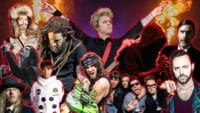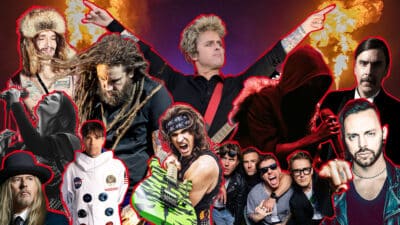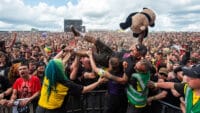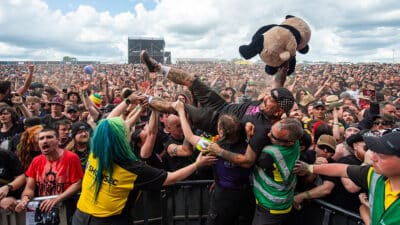Interview
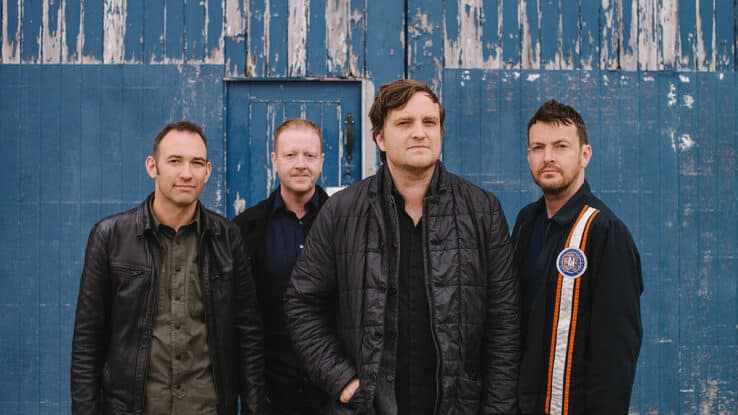
Interview
Stage Times: Starsailor
From Glastonbury to Sundance, Starsailor frontman James Walsh opens up his old gig diaries ahead of festival season and their milestone headline tour in November
After the lairy laddism of Britpop, the early noughties were boom times for the bands who could make bikers cry. If you didn’t shiver when Coldplay kicked into ‘Yellow’, feel your lip tremble when Travis hit the chorus of ‘Driftwood’ or stifle a sob at the clanging ivories of Keane’s ‘Somewhere Only We Know’, you were probably dead inside. Likewise, in 2001, only the emotionally stunted didn’t feel a spiritual stirring when Starsailor’s stormy breakthrough single, ‘Good Souls’, came roaring through the headphones of their first-generation iPod.
“It’s kind of crept up on us,” smiles frontman James Walsh as we congratulate him on Starsailor’s 25th anniversary: a milestone the band will toast in style with a UK tour through November, after much-anticipated sets at festivals this summer. But then, given their meteoric quarter-century, perhaps it’s no surprise that the founding line-up of Walsh, James Stelfox (bass), Barry Westhead (keys) and Ben Byrne (drums) haven’t had time to check their watches.
Formed in 2000 at Wigan And Leigh College, named after Tim Buckley’s classic 1970 album, and powered by Walsh’s mighty lungs – a sound as intense as a laser-cutter and poignant as war poetry – the four-piece were quickly snapped up by EMI. The following year’s debut album, Love Is Here, hit No.2, and following their anointment as Brightest New Hope at the NME Awards, they were off to the races.
Global radio hits like ‘Alcoholic’, ‘Four To The Floor’ and ‘Silence Is Easy’ – the latter produced by the troubled production genius Phil Spector in his final work – were inescapable, speaking to Starsailor’s talent for writing highly personal songs that struck a universal chord. The line-up put the miles in on the road, too, whether opening up for titans like U2 and The Rolling Stones, or on headline tours that made audiences weep their body weight everywhere from Argentina to South Korea.
In 2025, with six studio albums under their belts – including last year’s acclaimed Where The Wild Things Grow – the biggest problem they’ll face this year is choosing the setlist. And while Walsh admits their live career hasn’t all been smooth sailing – with a handful of horror gigs amongst the schoolboy-fantasy highlights – the singer believes there’s still something magical that happens when his band get onstage that can’t be replicated anywhere else. “I think that’s part of the beauty of it. You want people to come to the gigs and think, ‘Wow, that’s even better than it is on the record…’”
The gig that made you want to play music
For me, it was The Verve at Haigh Hall in Wigan. It was in 1998, right in that Urban Hymns period, and this was their big homecoming gig. It felt like an event and they had worked towards it. Their first album had come out in 1993, and all the hard work and tumultuous times had paid off with this unbelievable moment. I was 17 and it just illustrated the power of music. There’s something magical about seeing a band – and a frontman like Richard Ashcroft – at the absolute peak of their powers.
I’m sure we had a few drinks, but I stayed the right side of drunk, because I find that can spoil a gig a little bit. Ashcroft’s voice was superb that night and he seemed completely lost in the music. It sounds like a weird thing to say about someone with such stage presence, but he seemed more relatable and slightly less in-your-face than the Gallaghers. I was a huge fan of Oasis as well, but it was like, ‘There’s no point trying to be Liam Gallagher, because he’s got a completely different character’. That was definitely the gig I came away from thinking, ‘This is what I want to do’.
The first
We played quite a few little gigs around Wigan and Warrington, but I’m pretty sure the first one was at The Stocks in Padgate. It was the local pub that our bass player, Stel, and drummer, Ben, used to drink in. We somehow persuaded them to let us do a few tunes. I think we just had ‘Good Souls’ in the setlist at that point. Everything else was still to come. So we used to play Free covers, like ‘Be My Friend’ and ‘Oh I Wept’. We did a decent cover of The Beatles’ ‘Don’t Let Me Down’. We’re definitely a better live band now, but there was a youthful energy back then. Those early gigs were pretty loud – and sweaty!
I think we probably got paid a hundred quid between the four of us. You’d get a few pints out of that. But I can also remember a few early gigs in Manchester, where you’d have to sell the tickets yourself, and in exchange for bringing fifty people along, you’d get eight bottles of Stella! It sounds like exploitation, really, but when you’re young and being offered a gig in Manchester, that’s the dream.
The smallest
In terms of small places, I played a solo gig a couple of years ago in a bar outside Leeds that only had room for 20 people. But the smallest Starsailor gig when it comes to attendance was the Leicester Charlotte in 2000. What’s the opposite of an ego boost? That gig was, like, an ego deflation. Because we’d just done this gig at The Monarch in Camden, and we were starting to get some industry buzz, so it was absolutely packed and there wasn’t room to swing a cat. So then we were all cocky and confident about how things were going to go from strength to strength.
Our agent had booked us a couple of other gigs on our way back up north. So we arrived in Leicester. First of all, we struggled to find the venue. Then we genuinely just played to the support band. There was actually no-one else there. We were contractually obliged to do the set, so we just decided to treat it as a laugh. And then, on the way out of Leicester, we kept getting stuck in the one-way system. That night was a humbling experience.
The biggest
We played the Pyramid Stage at Glastonbury in 2004. I must admit, I was pretty nervous for that one. There’s always some butterflies before any gig. But that was definitely an occasion where the size of the crowd was overwhelming. You’re looking out on this sea of people, and maybe ten per cent of them are big Starsailor fans, and the rest are there because they’re thinking, ‘Well, there’s nothing else on’. I remember, the Black Eyed Peas and Paul McCartney were on after us. We had 45 minutes to put ourselves across to this huge crowd, and it all went by in a flash.
When we supported The Rolling Stones, those shows were on a massive scale too. We got to know Ronnie Wood fairly well, and he ended up playing guitar on one of our songs, ‘All The Plans’, which was an amazing experience. I remember, he had his own snooker room – and occasionally during the tour, he’d get Ronnie O’Sullivan to come and play a few frames! You can’t expect all 30,000 people who come to those shows to be interested in the support band, but I still meet people now who say, ‘I hadn’t heard of you before, but I saw you with the Stones, and now I’m a fan and I’ve seen you loads of times’. You can’t always tell where something is going to lead.
The weirdest
My weirdest solo gig was at a miners club in about 2010. I was on tour in Australia and I had gigs in Sydney, Brisbane, Melbourne and Adelaide – but because touring Australia is quite expensive, the budget was not quite ‘budget-ing’, so I asked, ‘Is there anywhere else I could play?’ So they managed to get me a gig in this mining town called Mackay. I’ve done gigs like this in the past, where it becomes clear that not everyone is a Starsailor fan. But this was a particularly difficult and unusual gig, because I didn’t get a reaction to anything I was playing. I started off with ‘Four To The Floor’, which was a hit in Australia – but obviously didn’t make it to Mackay. So I thought, OK, and I played some Beatles, Elvis – but they just weren’t having it. I remember this bloke coming up to me and asking, ‘Do you know any Cold Chisel…?’
The worst
We were invited to play the Sundance Film Festival in about 2001, which we were really excited about, because we thought, ‘We’re going to meet all these amazing people, watch some films, maybe meet Robert Redford, and someone might want to use our music in a film’. But it ended up being a baptism of fire into the world of corporate gigs. It was in some posh bar and when we started playing, people didn’t stop talking. You know how sometimes at a wedding, there’s a band playing in the corner, but it’s just background music and nobody feels obliged to listen? It felt like that. And because I wasn’t used to that kind of thing, I didn’t take it very well.
So I started having a go at the crowd, saying, ‘Can you at least turn around and watch us?’ and ‘You’re all dicks’ and ‘Who do you think you are?!’ I just completely lost it. It was a bit of a dark night for the band, because we ended up having a bit of a falling out afterwards. Our drummer, Ben, and our keyboard player, Barry, thought I’d been really unprofessional. It was definitely a valuable lesson. It’s better to be slightly sarcastic – and say something like, ‘You’ve been such a fantastic audience’ – than laying into people and having a massive go at them.
The best
T In The Park in 2004 was amazing. I guess it was similar to Glastonbury, where you look out at this huge crowd and feel completely overwhelmed by it. But I remember, when we started playing ‘Alcoholic’, everybody started singing along – to the extent that we were completely blown away by it. It’s hard to talk about without sounding egotistical, but there was just this massive cheer, and it felt like such an honour that all these people were there to see us, and knew so many of the songs. My mum is Scottish, for a start, so we’ve always had a great affinity with Scotland. It’s a place where they’re really loyal to bands. When a Scottish audience decides they like you, you can keep going back. They don’t pick up a band and then drop them when they’re not cool anymore. They’re with you to the end.




